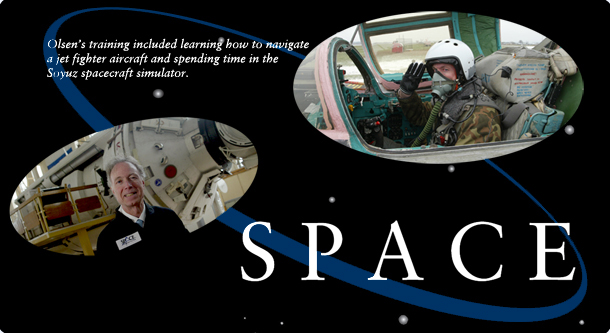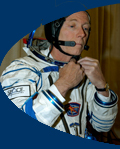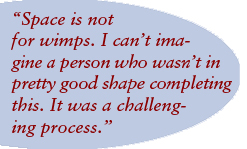

Preparing to Fly
The price tag of his space odyssey? $20 million. But for Olsen, it was worth every penny. Using his newly gained Russian language skills, he said, “Ya lyublu kosmos” (I love the cosmos). He believes strongly that space flight and research are critical for our future and can help us learn more about our planet.
Olsen said he does not consider himself a space tourist, instead he prefers the term space-flight participant. “Tourism implies that anyone can just write a check and go up there. That’s not what happened.”
Olsen certainly had to do a lot more than write a check. His preparation included 900 hours of intense physical training and studies. He lived in military-style barracks at the Yuri Gagarin Cosmonaut Training Center in Star City (named after the world’s first space traveler), near Moscow, rising at the crack of dawn and spending 12 hours per day in a flight simulator, mastering all the elements of the Soyuz spacecraft. He had classes and had to pass weekly tests in subjects like the “motion-control system,” life-support systems, electrical controls, radio operation along with practical simulations and survival exercises.
He also had to study the Russian language, which he said was actually the hardest part of training. “I love the Russian culture and wanted to learn the language. But I’ve never been good at languages and struggled to gain the basics.”


The physical training, he said, was very intense. He ran two miles each morning and had to pass strength training and reach specific times in 100- and 800-meter swims. He had to take zero-gravity flights and spin around in a centrifuge at speeds up to eight Gs of acceleration, that is eight times Earth’s gravitational pull. As he puts it, “Space is not for wimps. I can’t imagine a person who wasn’t in pretty good shape completing this. It was a challenging process. It challenges you physically, emotionally and intellectually.”
Olsen said he was fascinated with space as a child. “I remember Sputnik [1957] as a kid and vividly recall Apollo and Neil Armstrong’s lunar landing [1969]. I never imagined I would follow his footsteps in a small way, but it planted the seeds. Those events got me interested in science and engineering.”
But it wasn’t until he read about the first private citizens to visit the orbiting station, Dennis Tito and Mark Shuttleworth, that he appreciated the possibility of space travel. “It sounded like something I’d like to do and was also the right time of my life to do it.”
He added, “This undoubtedly was one of my greatest life accomplishments, and I look forward to continuing to share my experience. Hard work and determination led me to where I am today, and I encourage today’s youth to dream big.” more …
Opening Page | A Stellar Journey
Reaching Great Heights | Fueled by FDU
FDU Magazine Home | Table of Contents | FDU Home | Alumni Home | Comments
©Copyright 2006 Fairleigh Dickinson University. All rights reserved.
For a print copy of FDU Magazine, featuring this and other stories, contact Rebecca Maxon, editor,
201-692-7024 or maxon@fdu.edu.